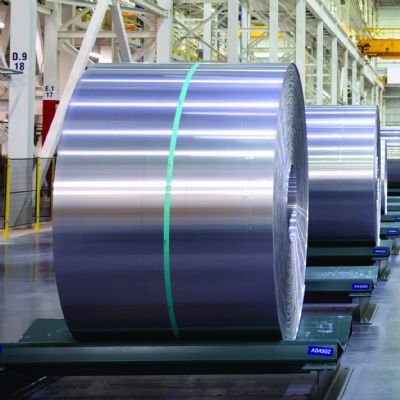 Peter Ulintz
Peter UlintzAlternative Forming Methods for Aluminum Alloys
December 1, 2018Comments
Formability of material at room temperature and the speed at which deformation occurs determine the degree of complexity at which aluminum alloys become elaborate shapes using traditional stamping dies.
To help overcome the limitations of temperature and speed, there are alternative forming methods such as stretch forming, super-plastic forming, warm forming and high-energy-rate explosive forming. The characteristics of each are presented here.
Stretch Forming
 |
| Fig. 1—Stretch forming |
Performed on a stretch press, gripping jaws attached to a carriage secure the sheetmetal along its edges and are pulled by pneumatic or hydraulic force to stretch the sheet (Fig. 1). Tooling consists of a solid contoured piece, known as a stretch-form block, against which the sheetmetal presses. As the form die drives into the sheet, the tensile forces increase until the sheet plastically deforms into its new shape.
The two basic types of stretch-forming equipment—longitudinal and transverse—stretch the workpiece along its length (longitudinal) and width (transverse). The presses ensure accuracy and efficiency, while CNC controls help provide part-to-part repeatability.
Superplastic Forming
Some alloys slowly stretch well beyond their normal limitations at elevated temperatures. For these, there’s superplastic forming (SPF), a process conducted at high temperature and under controlled strain rate to give a tenfold increase in elongation compared to conventional room-temperature processes.
The process begins by placing the sheetmetal in an appropriate SPF die, representative of the final part to be produced (Fig. 2). The sheet and tooling are heated and gas pressure (usually argon) applied to plastically deform the sheet into the shape of the die cavity. The pressure profiles must be closely controlled during the process, since alloys of interest exhibit SPF behavior only within specific temperatures ranges and strain rates. SPF processes produce parts that are impossible to form using conventional techniques. However, only specific alloys with the fine-grained microstructure and the strain rate sensitivity (m-value) necessary for SPF processes can be used.
Warm Forming
 |
| Fig. 2—Super-plastic forming |
Some studies show a significant increase in formability of 5XXX and 6XXX alloys with warm forming (T. Altan, G. Daehn, Ohio State University). The process makes possible the forming of complex sheet products that cannot be manufactured at room temperature, and at a lower cost than the SPF process.
With warm forming, the aluminum blank, and sometimes the die, heats to 200 to 300 C before stamping. The heating cycle results in longer cycle times, while the electrical heating rods in the dies and/or blankholder require more complex tooling and insulation.
Further development work is required to establish robust design guidelines for warm forming, due to its complexity.
Electrohydraulic (Explosive) Forming
 |
| Fig. 3—Electrohydraulic (explosive) forming |
A high-energy-rate method used primarily in the production of aluminum alloy parts for aerospace, electrohydraulic forming or explosive forming produces parts that exceed the size limits of conventional stamping equipment, or when forming pressures are unobtainable with conventional methods due to alloy strength and/or sheet thickness.
Unlike SPF, this process can be used with any aluminum alloy, with AA1100-O recognized as the most formable by explosive forming (ASM Specialty Handbook: Aluminum and Aluminum Alloys).
Cast iron and cast steel are commonly used for die materials. Only a die cavity is required because the underwater shock wave generated during explosive forming acts as the punch (Fig. 3). Prior to detonation, the air between the sheetmetal and die cavity must be evacuated. So great is the forming speed in explosive-forming operations that air trapped between the workpiece and the die can prevent the workpiece from reaching the targeted die surface.
Deformation velocities are known to exceed 100 m/s compared to approximately 6 m/s maximum for a conventional stamping process. The high-pressure levels in explosive forming can substantially increase the yield and tensile strength of the workpiece when critical forming velocities are exceeded.
High-energy and high-velocity forming of aluminum alloys is not limited exclusively to explosive forming. Other methods such as electrohydraulic and electromagnetic forming also have been used successfully, on a limited basis (G. Daehn, Ohio State University). MF
View Glossary of Metalforming Terms
Technologies: Materials







